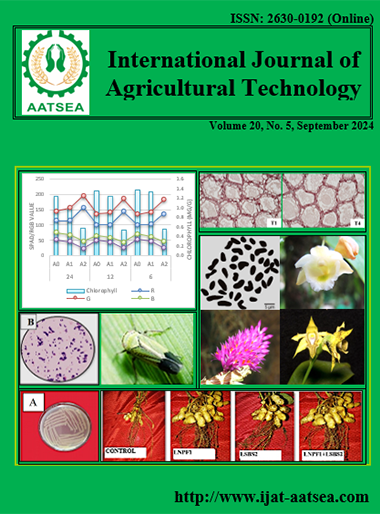Antioxidant and antibacterial activity of Curcuma spp. rhizome essential oil
Main Article Content
Abstract
Curcuma xanthorrhiza Roxb. (temulawak) rhizome essential oil showed the highest antioxidant activity (IC50) 380.95±18.49 ppm, with total phenolic 63.95±2.53 mg GAE/g, and total flavonoid 26.21±0.86 mg QE/g. Curcuma xanthorrhiza Roxb. rhizome essential oil showed the highest antibacterial activity with inhibition zone 11.93±0.43 mm towards Eschericia coli, inhibition zone 12.63±0.31 mm towards Staphylococcus aureus, MIC value 1.17% and MBC value 4.68% towards Eschericia coli, MIC value 1.13% and MBC value 4.52% towards Staphylococcus aureus. The main components of Curcuma xanthorrhiza Roxb. rhizome essential oil were p-cymene, ar-curcumene, 3,7-cyclodecadiene-1-one, and xanthorrhizol. The main components of Curcuma longa (turmeric) and Curcuma purpurascens (temu tis) rhizome essential oil were turmerone and curlone
Article Details

This work is licensed under a Creative Commons Attribution-NonCommercial-NoDerivatives 4.0 International License.
References
Ahmad, A. R., Juwita, Ratulangi, S. A. D. and Malik, A. (2015). Penetapan kadar fenolik dan flavonoid total ekstrak methanol buah patikala (Etlingera elatior (Jack) R.M.SM). Pharmacy and Science Journal, 2:1-10.
Anjusha, S. and Gangaprasad, A. (2014). Phytochemical and antibacterial analysis of two important Curcuma species, Curcuma aromatica Salisb. And Curcuma xanthorrhiza Roxb. (Zingiberaceae). Journal of Pharmacognosy and Phytochemistry, 3:50-53.
AOAC (Association of Official Analytical Chemist) (2005). Official Method of Analysis. Association of Official Analytical Chemist, Maryland.
Diastuti, H., Syah, Y. M., Juliawaty, L. D. and Singgih, M. (2014). Antibacterial Curcuma xanthorrhiza extract and fraction. Journal of Mathematical and Fundamental Sciences, 46:224-234.
Hashemi, S. M. B., Khaneghah, A. M. and Sant’Anna, A. D. S. (2018). Essential Oils in Food Processing: Chemistry, Safety and Applications. John Wiley & Sons Ltd, London.
Jantan, I., Saputri, F.C., Qaisar, M. N. and Buang, F. (2012). Correlation between chemical composition of Curcuma domestica and Curcuma xanthorrhiza and their antioxidant effect on human low-density lipoprotein oxidation. Evidence-Based Complementary and Alternative Medicine Journal, 1-10.
Koomson, D. A., Kwakye, B. D., Darkwah, W. K., Asante, M. and Aidoo, G. (2018). Phytochemical constituents, total saponins, alkaloids, flavonoids and vitamin C contents of ethanol extracts of five Solanum torvum fruits. Pharmacognosy Journal, 10:946-950.
Nadifah, F., Muhajir, N. F. and Retnoningsih, F. (2017). Daya hambat minyak atsiri rimpang kunyit terhadap pertumbuhan Candida albicans in vitro. Jurnal Vokasi Kesehatan, 4:1-5.
Nugraheni, R. W., Rahman, A. and Rakhmawati. (2017). Aktivitas antibakteri ekstrak etanol rimpang Curcuma domestica dari berbagai daerah terhadap Bacillus cereus dan Klebsiella penumoniae. Jurnal Ilmu Kesehatan, 173-179.
Preedy, V. R. (2016). Essential Oils in Food Preservation, Flavor and Safety. Elsevier, London.
Rouhollahi, E., Moghadamtousi, S. Z., Hajiaghaalipour, F., Zahedifard, M., Tayeby, F., Awang, K., Abdulla, M. A. and Mohamed, Z. (2015). Curcuma purpurascens Bl. rhizome accelerates rat excisional wound healing: involvement of Hsp70/Bax proteins, antioxidant defense, and angiogenesis activity. Drug Design, Development and Theraphy Journal, 9:5805-5813.
Sandhiutami, N. M. D. and Indrayani, A. A. W. (2012). Antioxidant activity test and determination of phenolic and flavonoid contents from buah merah (Pandanus conoideus Lam). Jurnal Ilmu Kefarmasian Indonesia, 10:13-19.
Setyawan, A. D. (2003). Keanekaragaman kandungan minyak atsiri rimpang temu-temuan (Curcuma). Jurnal Biofarmasi, 1:44-49.
Setyowati, A. and Suryani, C. L. (2013). Peningkatan kadar kurkuminoid dan aktivitas antioksidan minuman instan temulawak dan kunyit. Jurnal Agriteknologi, 33:363-370.
Shan, C. Y. and Iskandar, Y. (2018). Studi kandungan kimia dan aktivitas farmakologi tanaman kunyit (Curcuma longa L.). Jurnal Farmaka, 16:547-555.
Stanojević, J. S., Stanojević, L. P., Cvetković, D. J. and Danilović, B. R. (2015). Chemical composition, antioxidant, and antimicrobial activity of the turmeric essential oil (Curcuma longa L.). Journal of Advanced Technologies, 4:19-25.
Sukrasno, Kartika, Fidrianny, I., Elfahmi. and Anam, K. (2012). Influence of storage on the volatile oil content of Curcuma rhizome. Research Journal of Medicinal Plant, 6:274-280.
Sulaisyah, P. R. S. and Aminin, A. L. N. (2018). Antioxidant from turmeric fermentation products (Curcuma longa) by Aspergilus orzae. Journal of Scientific and Applied Chemistry, 21:13-18.
Suparmajid, A. H., Sabang, S. M. and Ratman. (2016). Pengaruh lama penyimpanan rimpang kunyit (Curcuma domestica Vahl) terhadap daya hambat antioksidan. Jurnal Akademika Kimia, 5:1-7.
Tahir, M., Muflihunna, A. and Syafrianti. (2017). Penentuan kadar fenolik total ektrak etanol daun nilam (Pogostemon cablin Benth.) dengan metode spektrofotometer UV-VIS. Jurnal Fitofarmaka Indonesia, 4:215-218.
Vitasari, R. A., Wibowo, F. R., Mariyana, S. D. and Wartono, M. W. (2016). Isolation and identification of curcumin and bisacurone from rhizome extract of temu glenyeh (Curcuma soloensis. Val.). Journal Science and Engineering, 1-5.
Yunita, M., Hendrawan, Y. and Yulianingsih, R. (2015). Analisis kuantitatif mikrobiologi pada makanan penerbangan (Aerofood ACS) Garuda Indonesia berdasarkan TPC (Total Plate Count) dengan metode Pour Plate. Jurnal Keteknikan Pertanian Tropis dan Biosistem, 3:237-248.


